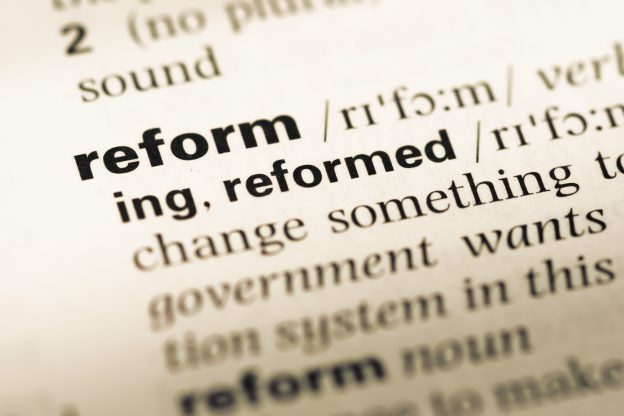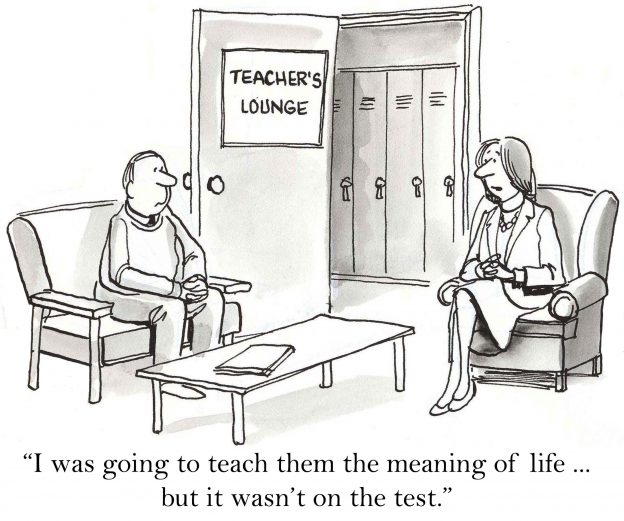The California Context
California Policymakers and Educators Shift from Test-and-Punish to Build-and-Support
by Bill Honig
Ensuring Adequate Funding Levels
Early in his term, Governor Brown sponsored Proposition 30, a tax increase initiative that temporarily raised income tax rates on top earners and provided for a ¼-cent sales tax increase. It passed. Those funds and the economic recovery in the state allowed the governor, working with the state legislature, to increase per-pupil funding for K–12 by about 40% during his first term. The hefty increase was designed to make up for the precipitous drop in support caused by the recession. The governor and the legislature also revamped the educational funding system under the Local Control Funding Program (LCFP). It now gives districts more flexibility in how to manage their funds and to provide additional resources for high-risk students.
Adopting a Rigorous, Standards-Based Liberal Arts Curriculum
After widespread discussions, the State Board of Education (SBE) in California approved the Common Core State Standards (CCSS), the Next Generation Science Standards (NGSS), the English Language Arts (ELA) Standards, and the English Language Development (ELD) Standards. The later two were both later integrated into the ELA/ELD Framework. It also signed on to the CCSS-aligned Smarter Balanced Assessment Program (SBAC). California policymakers were careful to emphasize that the primary purpose of the assessments was to feed back information to improve instruction, not for high-stakes consequences. At the same time, they eliminated a cluster of existing state tests. The SBE, backed by the political establishment, postponed testing until the new SBAC tests were ready and refused to submit to federal pressure requiring that testing be tied to teacher evaluations. The state legislature also gave the SBE two years to devise a new accountability system.
Delivering High-Quality Instruction
Recognizing the need for additional support, the SBE authorized the development of frameworks to advise teachers and districts on how best to translate the standards into curriculum and instruction, deliver effective professional development, build collaborative teams, and adopt instructional materials consistent with the standards.
Useful California Content Frameworks and Support Documents
- English Language Arts/English Language Development Framework for California Public Schools
- Executive Summary: English Language Arts/English Language Development Framework for California Public Schools
- California’s Recently Adopted English Language Arts/English Language Development Framework: Translating the Common Core State Standards to a Coherent and Sequenced Curriculum for All Students
- Resource Guide to the Foundational Skills of the California Common Core State Standards for English Language Arts and Literacy in History/Social Studies, Science, and Technical Subjects
- Mathematics Framework for California Public Schools
- Executive Summary: Mathematics Framework for California Public Schools
- Making Meaning of the California Mathematics and ELA/ELD Frameworks–Helpful Tools for Every Audience (a white paper on how to use the frameworks)
- History-Social Science Framework for California Public Schools (Draft)
- Science Framework for California Public Schools (Draft)
These frameworks have been widely supported in the state. The California Department of Education, county offices, districts, educational organizations, newly created networks of schools and districts, and especially the state teacher unions have been aggressively pursuing the implementation of the more active and deeper instruction envisioned by the CCSS. The California Teachers Association has been in the forefront of standards implementation efforts and has formed partnerships with Stanford and other educational entities to that end.
In 2012, State Superintendent Tom Torlakson formed a prestigious commission chaired by Linda Darling-Hammond and Chris Steinhauser. Darling-Hammond is one of the most respected school improvement researchers in the country, and Steinhauser is superintendent of the Long Beach Unified School District, which was designated one of the top school districts in the world. The commission produced Greatness by Design, a superb policy document that provides the blueprint for a Build-and-Support strategy in the state. In 2015, it followed up with A Blueprint for Great Schools: Version 2.0. These documents have had a major influence on practice in California, as has the expert advice of Michael Fullan.
In addition, the governor and the legislature invested almost $2 billion specifically for supporting the CCSS implementation and associated curricular and assessment changes and another $500 million for similar purposes in the 2015 budget. That latest allocation also included attracting, training, inducting, and supporting new teachers as one of the primary goals of the item, consistent with the recommendations of Greatness by Design, although there is still much to be done to revitalize the teaching profession.
Creating Useful and Fair Accountability Systems
In California, political and educational leaders proposed and the legislature enacted a plan to develop a new assessment and accountability system using multiple measures of student performance. The primary goal of the new system is to feed back information that will support local improvement efforts and not to punish schools and teachers. State leaders also created a new entity, the California Collaborative for Educational Excellence, to support and review the CCSS and LCFP implementation and organize site visits and support for struggling schools.
Most districts have been hard at work on the day-to-day business of implementing the Common Core State Standards. In addition, two effective networks of districts have been collaborating on the CCSS implementation. One network, CORE Districts, is composed of some of the largest districts in the state; the other is the California Collaborative on District Reform. CORE Districts obtained a federal waiver to develop its own broader assessment system (although it had to agree to test-based teacher evaluation, which each district will soon be able to ignore under the new Every Student Succeeds Act (ESSA).
Engaging Stakeholders
A potent informal network funded by foundation support, the Consortium for the Implementation of the Common Core State Standards, was formed with representatives from major educational and government entities, districts, county education offices, teacher groups, the research community, higher education, and advocacy groups. It has helped on such key issues as implementation planning, coordinating the work of support providers, communication, technology, understanding the state mathematics and ELA/ELD frameworks, accountability, and new teacher policies. Its first publication, Leadership Planning Guide California, was intended to assist districts and schools in addressing the implementation of the CCSS. In 2015, the consortium produced user-friendly summaries of the math and ELA/ELD frameworks.
Resisting High-Stakes Testing
Moreover, almost every educational group has joined the political and educational leadership and the legislature to successfully resist federal demands for excessive high-stakes testing and accountability and not-ready-for-prime-time student and teacher evaluation schemes. The one exception has been the CORE Districts, which sought a waiver from severe No Child Left Behind (NCLB) penalties and were forced to accept test-driven teacher evaluation as the price for the waiver. Many of the districts are now struggling with implementing those evaluations, which have caused disharmony within the districts. In addition, although many in management continue to support such measures as test-driven teacher evaluation, their numbers are decreasing in the face of the Build-and-Support agenda being promoted by educational leaders across the state. Finally, the presidents and chancellors of the four higher education segments all signed a letter pledging support for the Common Core State Standards.
A brief summary of California’s approach is available in a slide presentation by Michael Kirst and an article in CALmatters, “A Stanford Professor’s High-Stakes Plan to Save California Schools.” See also Jeff Bryant’s 2015 interview of me in Salon and his follow-up article on California as a potential role model for the country. Lastly, see Charles Kerchner’s blog post, “Can the ‘California Way’ Turn Around Underperforming Schools?”
How California Avoided the Push-Back Against the Common Core
There is widespread backing for Common Core in the state thanks to these efforts, particularly the tempered rolling out of the CCSS, the postponing of testing and accountability to allow time for implementation, and the divorcing of accountability from evaluations. The resistance to the CCSS that has erupted in other states from abrupt implementation and tying the standards themselves to high-stakes accountability has not occurred in California. The study Leveraging the Common Core to Support College and Career Readiness in California reports finding widespread excitement among high school teachers for the promise of the more active instruction offered by the CCSS.
In 2015, a poll by Children Now found 67% support among the general public in California for the CCSS. Interestingly, if respondents were asked only about the ideas behind the standards, without mentioning the name Common Core, support rose to between 85% and 93%. The findings were similar for parents who had children in public schools, and for those employed in the education field, 82% expressed support for the standards.
Build-and-Support Is Working in California
In 2013, Secretary of Education Arne Duncan praised a few cherry-picked states that had followed the administration’s proposed reforms and improved their National Assessment of Educational Progress (NAEP) results. Duncan failed to mention the larger number of states that had also implemented the policies but did not grow and experienced lackluster results overall. In a glaring case of omission, Duncan never acknowledged California’s reform efforts, which, although resisting many of the federal reform policies, topped the nation in growth in eighth-grade scores.
That trend has continued. From 2009 to 2015, California was first in growth, along with Washington, DC, in eighth-grade scaled reading score growth—up six points from 2009 compared to the national growth rate of one point. California was among the four-highest states in eighth-grade growth in mathematics—up five points from 2009 compared to a national decline of one point. California did not fare as well on NAEP fourth-grade scores. They have remained low with flat growth, mirroring the rest of the nation.
Added note: 2017 NAEP results have accelerated this trend, though there is still much work to do.
NAEP 8th and 4th Grade Reading and Math Average Scaled Score Growth for 2009-2017 California has the most second language students, the most diversity, and high levels of low income children compared to other states. Top growth scores nationally for 8th grade reading, 4th grade reading, 8th grade math. Weak growth for 4th grade math. Reading: 8th grade: First in the nation. California growth +10 and now within 2 points of the national average. National growth +3 https://www.nationsreportcard.gov/reading_2017/#states/scores?grade=8 4th grade: Tied for 2nd nationally California growth +6 and now within 6 points of the national average. National growth +1 https://www.nationsreportcard.gov/reading_2017/#states/scores?grade=4 Math: 8th grade: Tied for 2nd nationally. California growth +6, Now within 5 points of the national average. National growth 0. https://www.nationsreportcard.gov/math_2017/#states/scores?grade=8 4th grade: Tied for 15th in growth +1. 7 points behind nationally. National growth 0. https://www.nationsreportcard.gov/math_2017/#states/scores?grade=4 Gaps have actually narrowed in the state. White student scores have not grown as fast as Hispanic and Black children. Some subgroup info: Hispanic growth scores for reading 2009-2017; 8th grade reading +10; 4th grade reading +8 Black: 8th grade +7; 4th grade -1!!!. Hispanic growth scores for math: 8th grade +6; 4th grade +4 Black: 8th grade +5; 4th grade +1 Two California Urban Districts under the Federal Trial Urban District Assessment (TUDA) program showed top gains in NAEP. LA: 8th grade reading average score growth 2009-2017. +11. 1st in nation. https://www.nationsreportcard.gov/reading_2017/#/districts/scores?grade=8 4th grade reading: +10; 1st in nation (Tied DC) 8th grade math: +8 (Tied for 3rd) 4th grade math: +1 (Not good—tied for 7th) San Diego 8th grade reading: +10. (2nd nationally after LA) https://www.nationsreportcard.gov/math_2017/#districts/scores?grade=8 4th grade reading: +9. (tied for 2nd nationally) 8th grade math: +3 (tied for 7th) 4th grade math +1 (tied for 7th) Another set of data from the Urban Institute app which adjusts NAEP scores for language, poverty, race, and special ed. And whether the adjustments are accurate or not, comparisons using the same standards are legit. http://apps.urban.org/features/naep/ One caveat is that the intervals on the ranks are still being scaled which might change rank growth somewhat but the overall picture will remain very similar. I took off the age control but let the others stay. (If you look at the website be sure to refresh after looking at math to allow you to click from math to reading and when you do remember to put off the age control) These data are ranks based on average scores, and if you mouse over the state it shows the growth in rankings. It is apparent that California has made large jumps in rankings this year from the past few years. (Florida has not grown as much but is at the top or near the top nationally in all the rankings—whether from state policy or district independent efforts needs to be determined)
In 8th grade reading we are now 14th in the country up from the low 40’s as recently as 2013. In 4th grade reading we are 19th in the country up from the high 30’s in 2015.
In 8th grade math we are 22nd up from the low 40’s as recently as 2013.In 4th grade math (our weakest area where we need to undertake considerable work) we are 37th up from the low 40’s in 2011 and 2015.
Some confirmation is provided by our most recent state testing, the SBAC. 11th grade reading scores. 60% now reach the “proficient” level—a level consistent with 4yr college work and the NAEP proficiency level which compares favorably to the other SBAC states that are much less diverse. To me, getting 60% of our diverse students to that level is impressive and a tribute to the hard work of our educational practitioners and policy direction. On the other hand, the state is much weaker in SBAC math performance at 11th grade (although improving) and math will be a major area of subsequent improvement efforts.
In addition, from 2010 to 2015, the Golden State improved its high school graduation from 74.7 to 82.3, an increase of 7.6 points, which is significantly greater than the improvement in the national rate. Despite having one of the most diverse student bodies in the nation, the state graduation rate is now higher than the national average. California Latino and African-American students progressed even faster. The rate of Latinos has increased 15% since 2010 to 78.5%; African-American students increased 11% to 70.8. Finally, in 2015, 43.4% of graduates completed all the necessary coursework to meet the minimum admissions requirements for the University of California and the California State University systems, a substantial jump from the 36.3% meeting the requirements in 2010.
Even though California scores have been increasing on NAEP, at least at the eighth-grade level, student achievement must improve substantially in the next decade. The first Smarter Balanced assessments based on the Common Core State Standards were given in 2015 and formed the base year for determining growth rates and improvements.
Preliminarily, SBAC reported four levels—standard exceeded, standard met, standard nearly met, and standard not met. It is important to understand what “standard” means. It was established to be comparable to the NAEP proficiency standards, which predict success in a four-year college credit-bearing course. Massachusetts, whose students score among those in the top countries worldwide, is the only state in which just over 50% of its students score proficient on NAEP.
The number of students in California meeting or exceeding the standard on the SBAC test at 11th grade is one indication of how many students are being adequately prepared for both four-year colleges and community colleges where students transfer to four-year colleges after two years or to one of the more demanding career tech pathways.
The 2015 scores in the 11th grade were decent in English language arts—58% of students reached the four-year college-bound level. The scores were low in mathematics—only 28% reached or exceeded the college-bound standard. This may be due to the shift in instruction called for by the CCSS or the greater language demands of the math test, or the test may have been too dependent on Intermediate algebra, which is not appropriate for many career paths. Researchers are currently examining the discrepancy between student performance in math and reading.
At elementary and middle grades, the percentage of students meeting the on-track to a four-year college standard was generally in the mid-30% in math and mid-40% in reading. The achievement gaps between low-income children or children of color and their higher-income or Caucasian peers increased from previous tests. This is most likely due to the fact that the new SBAC assesses deeper learning and provides a more accurate picture of actual performance.
Meeting the Challenges of Diversity and Underfunding
California has one of the most diverse groups of K–12 students in the nation: 54% Hispanic/Latino; 25% white; 12% Asian, Pacific Islander, or Filipino; 6% African-American; 3% mixed race; and 0.6% Native American. Its English-language learner (ELL) population is 25%, the largest in the nation. The states with the next largest ELL populations are Texas with 15%, Florida with 10%, and New York with 9%. Our state also ranks high in poverty levels.
Importantly, California spends significantly less per pupil than other states. In 2014–2015, it ranked 42nd after adjusting for cost of living, and it is significantly behind other states in additional support measures that affect school quality as well.
Yet, compared to the 12 other states that took the SBAC, California ranked in the middle of 11th-grade scores for both reading and math. None of the other states are as diverse. In the lower grades, however, California was either at the bottom or near the bottom. Unquestionably, much work is to be done in the state, but the Build-and-Support policy framework being pursued offers the best chance of substantial improvement during the next decade.
Career Tech Pathways
Many of us in California have one major problem with the Common Core State Standards, which is how the SBAC standards were set and how the CCSS in general are portrayed in the media. Although the literature maintains that the goal is “career and college readiness,” as I explained above, the high school standards are actually primarily aimed at preparing students for four-year colleges or alternative career paths that demand the highest educational levels. This is particularly true of third-year high school courses in mathematics.
Many have questioned whether intermediate algebra (made more demanding by Common Core Standards) is an appropriate course for those preparing to be dental hygienists or to be trained in precision manufacturing. For those tech/prep students, rigorous substitutes such as statistics and quantitative reasoning or embedding these subjects in career tech application courses seems to be a better alternative. In fact, many states have pursued this direction. For example, Texas just recently changed its requirements.
The Charles A. Dana Center in Texas recently examined 34 career paths—from accounting to visual communication—to determine which math skills were needed. Most careers only demanded the use of the math learned through eighth grade that can be applied in complex and unique situations. See also “Programs of Study & Mathematics Alignment” on the Dana Center’s website. It presents an analysis of the mathematical demands for nursing, communications, criminal justice, and social work.
Currently, about 40% of students nationally reach the levels needed for succeeding in a credit-bearing four-year college course. We should definitely be trying to increase that number, and the Common Core State Standards are valuable for that goal. Yet even for the college bound some flexibility is warranted. The University of California’s Board of Admissions and Relations with Schools (BOARS) establishes the courses that count for college admission, and the state university and community college systems follow its lead. Recently the BOARS committee approved some substitutions for intermediate algebra http://senate.universityofcalifornia.edu/_files/committees/boars/documents/BOARSStatementonStatway.pdf and the community colleges are considering changes along these lines.
But that still leaves a large number of students who could profit from rigorous tech-prep pathways yet are usually neglected in a system that is primarily geared for the four-year college bound. California has lagged behind some other states showing leadership in developing these pathways such as Illinois, but it is now devoting resources and attention to this problem.
Robert Schwartz, of Harvard University’s Graduate School of Education, has been one of the major national proponents of improving the pathways for the non–four-year college bound. See his Pathways to Prosperity: Meeting the Challenge of Preparing Young Americans for the 21st Century and Career Pathways: A Route to Upward Mobility, a paper he coauthored with Nancy Hoffman. The Thomas B. Fordham Institute also has been promoting alternative pathways. See the papers and video presentations from its Education for Upward Mobility Conference that are devoted to the issue. David Conley and Linda Darling-Hammond have also been champions of this approach. See the handouts on the California Department of Education web page that summarize their work. For a California perspective, see Career Technical Education Pathways Initiative, and for a national perspective, see The State of Career Technical Education. See also the fall 2014 online issue of American Educator, which is devoted to this topic.
Pamela Burdman has authored three excellent reports on mathematics college placement issues in California sponsored by the Policy Analysis for California Education (PACE) as well as a short article on the inaccuracies of college placement exams. A compendium of research from a conference on this subject can be found at a LearningWorks conference on the future of college math placement. The conference focused on three main issues:
- Are there alternative paths to college other than the usual mathematics sequence that ends in intermediate algebra such as statistics or quantitative reasoning?
- Is relying on a placement test an accurate and fair way to force students into remedial classes based on Algebra 2, which many will not pass. Are there better alternatives? Placement tests provide only a tiny percentage improvement on the predictions generated by merely relying on transcripts but do result in high levels of misplacement.
- Are there more successful ways to teach the remedial classes?
In 2016, a major report by the Center for Community College Student Engagement made similar points about the deficiencies in our system of remediation, and a summary of the research demonstrates the defects of community college placement exams that 87% of community college students are forced to take.
Some extremely effective groups have been formed to support alternatives for the college bound and programs that offer rigorous preparation for the tech/prep bound. Among them are Linked Learning and ConnectEd. See also the High Tech High charter organization, which is devoted to school/career integration with an emphasis on project-based learning, and the many career academies that over the past two decades have been providing successful career preparation in important fields such as health, business, and manufacturing.
California has invested one-and-a-half-billion dollars in collaborative tech/prep grants aimed at two-year community college pathways to careers or four-year colleges or apprenticeships. This has been accomplished under the leadership of Governor Brown and the state legislature, with the full support of State Superintendent of Public Education Tom Torlakson. The investments have been made over the past few years and are slated to continue for the next few years.
Although some civil rights advocates are reluctant to support the premise that it is an unattainable goal for all students to become prepared for four-year institutions of higher learning, we are doing a disservice to many youngsters by only concentrating on that pathway. Many students who could succeed in a rigorous alternative route will falter under a four-year college prep sequence. These substitute pathways are a far cry from the old vocational education, which often became a dumping ground for low-performing students and devolved into tracking for minority and low-income students. One policy goal should be to maximize the number of students who qualify, attend, and graduate from four-year colleges, but we should also attend to the needs of those students who could profit from a rigorous tech/prep pathway.
The jury is still out on whether our large, diverse state will successfully implement the ambitious instructional program envisioned by the Common Core Standards over the next decade by following a Build-and-Support approach. So far, so good.
Recent Developments
7/30/2016. Michael Petrilli has edited a just-released book Education for Upward Mobility (2016). This work contains essays under three headings. First, Transcending Poverty through Education, Work, and Personal Responsibility which includes chapters on the “Success Sequence” (graduate high-school, obtain a full-time job, and wait to have children until 21), tech-prep pathways, certification, and apprenticeship. Second, Multiple Pathways in High School: Tracking Revisited? which includes chapters on small schools of choice, college-prep high schools for the poor, and high-quality career and technical education. Finally, there is a section, The Early Years with chapters on the importance of the first five years, the centrality of knowledge acquisition in the elementary years, and issues of tracking in middle schools. Many of these authors support the main points in the article above.
7/30/2016 Two reports from the Education Commission of the States on what states require for early reading. California doesn’t do as much as many other states. Although our ELA/ELD framework is solid, we are missing some of the other infrastructure. http://www.ecs.org/50-state-comparison-k-3-quality/; http://www.ecs.org/companion-report-50-state-comparison-k-3-quality/
Reference Notes
Adopting a Rigorous, Standards-Based Liberal Arts Curriculum
Fensterwald, J. (2015, Jun 22). State Board Gets Extra Year to Create Measures of School Progress. http://edsource.org/2015/state-board-gets-extra-year-to-create-measures-of-school-progress/818666
Delivering High-Quality Instruction
Fensterwald, J. (2014, Dec 1). CTA Launches Large-Scale Teacher Training. http://edsource.org/2014/cta-launches-large-scale-teacher-training/70687#.VLg-31fF9D9
Tom Torlakson’s Task Force on Educator Excellence. (2012, Sep 17). Greatness by Design: Supporting Outstanding Teaching to Sustain a Golden State. California Department of Education. http://www.cde.ca.gov/eo/in/ee.asp
Blueprint 2.0 Planning Team. (2015, Jul 27). A Blueprint for Great Schools: Version 2.0. State Superintendent of Public Instruction. California Department of Education. http://www.cde.ca.gov/eo/in/bp/bp2contents.asp
Fullan, M. (2015, Jan). A Golden Opportunity: The California Collaborative for Educational Excellence as a Force for Positive Change. http://www.michaelfullan.ca/california-release-a-golden-opportunity/
Mead, S., Aldeman, C., Chuong, C., & Obbard, J. (2015, Jul 28). Rethinking Teacher Preparation: Empowering Local Schools to Solve California’s Teacher Shortage and Better Develop Teachers. http://bellwethereducation.org/publication/Rethinking_Teacher_Prep_California See also Ellison, K., & Fensterwald, J. (2015, Jul 14). California’s Dwindling Teacher Supply Rattling Districts’ Nerves. http://edsource.org/2015/californias-dwindling-teacher-supply-rattling-districts-nerves/82805
Creating Useful and Fair Accountability Systems
CORE Districts. http://coredistricts.org/
California Collaborative on District Reform. http://cacollaborative.org/topics/district-collaboration
Engaging Stakeholders
Consortium for the Implementation of the Common Core State Standards. (2013, Oct). Leadership Planning Guide California: Common Core State Standards and Assessments Implementation. California County Superintendents Educational Service Association. http://ccsesa.org/ccsesa-common-core-leadership-planning-guide-now-available/
Yakes, C., & Sprague, M. (2015). Executive Summary: Mathematics Framework for California Public Schools: K–12. California Department of Education. http://www.scoe.net/castandards/
Slowik, H Y., & Brynelson, N. (2015). Executive Summary: English Language Arts/English Language Development Framework for California Public Schools: K–12. California Department of Education. http://www.scoe.net/castandards/Pages/default.aspx
Gewertz, C. (2014, Sep 4). California Higher Education Systems Pledge Common-Core Support. http://blogs.edweek.org/edweek/curriculum/2014/09/california_higher_education_sy.html
Resisting High-Stakes Testing
Kirst, M. W. (2015, Jul). California Education Policy Overview 2015. Education Policy Fellowship Program. http://c.ymcdn.com/sites/epfp.iel.org/resource/resmgr/AERA_IEL/Final_MK_IEL-AERA_July_2015_.pdf
Lin, J. (2016, Jun 4). A Stanford Professor’s High-Stakes Plan to Save California Schools. https://calmatters.org/articles/a-stanford-professor-disrupts-california-schools/
Bryant, J. (2015, Apr 14). Common Core Consequences: What Currently Passes for “Reform” Has Caused Considerable Collateral damage to Schools and Teachers. http://www.salon.com/2015/04/14/common_core_consequences_what_currently_passes_for_reform_has_caused_considerable_collateral_damage_to_schools_and_teachers/
Bryant, J. (2015, Apr 23). An Alternative to Failed Education “Reform,” If We Want One. http://educationopportunitynetwork.org/an-alternative-to-failed-education-reform-if-we-want-one/
Kerchner, C.T. (2016, Jun 6). Can the “California Way” Turn Around Underperforming Schools? http://blogs.edweek.org/edweek/on_california/2016/06/can_the_california_way_turn_around_underperforming_schools.html
How California Avoided the Push-Back Against the Common Core
Freedberg, L. (2016, Jan 10). Common Core: New York Stumbles, California Advances on Common Core Implementation. http://edsource.org/2016/new-york-stumbles-california-advances-on-common-core-implementation/92986
Venezia, A., & Lewis, J. (2015, Aug). Leveraging the Common Core to Support College and Career Readiness in California. Education Insights Center. California State University, Sacramento. http://edinsightscenter.org/Publications/ctl/ArticleView/mid/421/articleId/1007/Leveraging-the-Common-Core-for-College-and-Career-Readiness-in-California
Children Now. (2015, Apr 20). New California Poll Shows Strong Support for Common Core and Its Approach. http://www.childrennow.org/about-us/press-releases/new-california-poll-shows-strong-support-common-core-and-its-approach/
Build-and-Support Is Working in California
National Center for Education Statistics. (2015). NAEP State Profiles. U.S. Department of Education. Institute of Education Sciences. http://nces.ed.gov/nationsreportcard/states/?utm_source=Michael%27s+daily+email%2C+Oct.+28%2C+2015&utm_campaign=Daily_4-24-15&utm_medium=email
Leal, F. (2016, May 17). California’s Graduation, Dropout Rates Improve for the Sixth Straight Year. http://edsource.org/2016/californias-graduation-dropout-rates-improve-for-the-sixth-straight-year/564357?utm_source=May+18+digest+Jane&utm_campaign=Daily+email&utm_medium=email
Blume, H. (2015, Sep 11). Achievement Gaps Widen for California’s Black and Latino students. Los Angeles Times. http://www.latimes.com/local/lanow/la-me-ln-achievement-gaps-widen-20150911-story.html
Meeting the Challenges of Diversity and Underfunding
Lucile Packard Foundation for Children’s Health. Public School Enrollment by Race/Ethnicity. http://www.kidsdata.org/topic/36/publicschoolenrollment-race/table – fmt=451&loc=2,127,347,1763,331,348,336,1&tf=84&ch=7,11,621,85,10,72,9,73&sortColumnId=0&sortType=asc
Federal Education Budget Project. (2012, Mar 28). Student Poverty Rate. http://febp.newamerica.net/k12/rankings/cenpov
Kerchener, C. T. (2015, Nov 23). Tax Proposals Would Lift California’s Low School Funding. http://blogs.edweek.org/edweek/on_california/2015/11/tax_proposals_would_lift_californias_low_school_funding.html
Kaplan, J. (2015, Nov). California’s Support for K-12 Education Ranks Low by Almost Any Measure. http://calbudgetcenter.org/?s=fact+K-12
Smarter Balance Results by State: 2014–2015.http://edsource.org/smarter-balanced-results/state.html and McCrea, D. (2015, Nov. 20). Personal letter to author.
Career Tech Pathways
Schulzke, E. (2015, Dec 12). How Much Math Do College-Bound Students Really Need? http://www.deseretnews.com/article/865643586/As-math-standards-nudge-upward-is-it-time-for-a-national-dialogue-on-how-much-math-high-schoolers.html
Fechter, J. (2014, Jan 31). State Nixes Algebra 2 for Most Students, Offers Other Math Options. http://www.mysanantonio.com/news/education/article/State-nixes-Algebra-2-for-most-students-offers-5194326.php
The Charles A. Dana Center. (2013, Jul). What Students Need to Know: Mathematics Concept Inventories for Community College Workforce Education Programs. The University of Texas at Austin. http://www.utdanacenter.org/higher-education/higher-education-resources/policy-resources/programs-of-study-mathematics-alignment/
The Charles A. Dana Center. Programs of Study & Mathematics Alignment. The University of Texas at Austin. http://www.utdanacenter.org/higher-education/higher-education-resources/policy-resources/programs-of-study-mathematics-alignment/
UC Board of Admissions and Relations with Schools. (2015, Jan 16). Statement on Approval of Statway. University of California. http://senate.universityofcalifornia.edu/committees/boars/documents/BOARSStatementonStatway.pdf See also UC Board of Admissions and Relations with Schools. (2013, Jul). Statement on Basic Math for All Admitted UC Students. http://senate.universityofcalifornia.edu/committees/boars/BOARSStatementonMathforAllStudentsJuly2013.pdf
Walton, I. (2013, Jun). Alternatives to Traditional Intermediate Algebra. Academic Senate for California Community Colleges. http://www.asccc.org/content/alternatives-traditional-intermediate-algebra
Symonds, W. C., Schwartz, R., & Ferguson, R. F. (2011). Pathways to Prosperity: Meeting the Challenge of Preparing Young Americans for the 21st Century. Cambridge, MA: Pathways to Prosperity Project, Harvard University Graduate School of Education. https://dash.harvard.edu/handle/1/4740480
Schwartz, R., & Hoffman, N. (2014, Dec 2). Career Pathways: A Route to Upward Mobility. edex.s3-us-west-2.amazonaws.com/Schwartz-Hoffman%20Paper-KLM%20(1).pdf
Thomas B. Fordham Institute. (2014, Dec 2). Education for Upward Mobility. http://edexcellence.net/publications/education-for-upward-mobility The papers from this conference have been published in a 2015 book edited by Michael Petrilli, Education for Upward Mobility, and a second video conference on the book was held in 2016. http://edexcellence.us6.list-manage.com/track/click?u=628bd73f1e90c900ee5ef4166&id=7894a573bc&e=ebbe04a807
California Department of Education. PSAA Meeting Webcast Archive 2014. Meeting Handouts. http://www.cde.ca.gov/ta/ac/pa/psaawebcastarchive14.asp#dec2014handouts
California Community Colleges Chancellor’s Office. (2013, Aug). Career Technical Education Pathways Initiative. http://californiacommunitycolleges.cccco.edu/Portals/0/reportsTB/REPORT_CTEPathwaysInitiative_082613_FINAL.pdf
Advance CTE. The State of Career Technical Education. http://www.careertech.org/state-CTE
American Federation of Teachers. (2014, Fall). American Educator. http://www.aft.org/ae/fall2014
Burdman, P. (2015). Publications. Policy Analysis for California Education (PACE). http://edpolicyinca.org/authors/pamela-burdman
Burdman, P. (2015, Nov 5). Math Placement Tests Deserve More Scrutiny. http://edsource.org/2015/math-placement-tests-deserve-more-scrutiny/90132?utm_source=Nov.+6+newsletter+John&utm_campaign=Daily+email&utm_medium=email
Learning Works. (2015, Nov 10). Testing and Beyond: A Summit on the Future of College Math Placement. http://www.learningworksca.org/testing-and-beyond-conference-nov-10th-2015-oakland-california/
Center for Community College Student Engagement. (2016). Expectations Meet Reality: The Underprepared Student and Community Colleges. The University of Texas at Austin, College of Education, Department of Educational Administration, Program in Higher Education Leadership. http://www.ccsse.org/nr2016/
Belfield, C., & Crosta, P. M. (2012, Feb). Predicting Success in College: The Importance of Placement Tests and High School Transcripts. Columbia University Teachers College Community College Research Center. http://ccrc.tc.columbia.edu/publications/predicting-success-placement-tests-transcripts.html
Linked Learning Alliance. http://www.linkedlearning.org/
The California Center for College and Career (ConnectEd). www.connectedcalifornia.org
High Tech High. www.hightechhigh.org
Leal, F. (2016, Jan 26). $1.5 Billion Helping Career Pathways Take Off in California’s High Schools. http://edsource.org/2016/1-5-billion-helping-career-pathways-take-off-in-californias-high-schools/93950
 Building Better Schools
Building Better Schools






